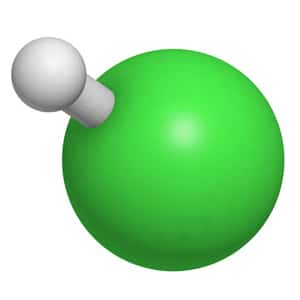
How It’s Used
Hydrogen chloride (aka chlorane) is a colorless gas with a sharp, pungent odor. The compound fumes strongly in moist air. It is used in the production of fertilizers, dyes, in electroplating, and in the photographic, textile, and rubber industries. HCl is used in the manufacture of organics such as dichloroethane and vinyl chloride—used to manufacture PVC (polyvinyl chloride). It is used to effectively regulate the pH level of a wide variety of manufacturing processes including the production of drinking water (likewise in swimming pool purification), foods, and pharmaceuticals.
Hydrogen chloride is also employed to “pickle” steel (removing rust and scale from the material), and in the processing of leather.
Occupational Health/Toxicology
Hydrogen chloride is irritating and corrosive to any tissue it contacts. Brief exposure to low levels causes throat irritation. Exposure to higher levels can result in rapid breathing, narrowing of the bronchioles, blue coloring of the skin, accumulation of fluid in the lungs, and even death. Some people may develop an inflammatory reaction to hydrogen chloride. This condition is called reactive airways dysfunction syndrome (RADS), a type of asthma caused by some irritating or corrosive substances.
Depending on the concentration, hydrogen chloride can produce from mild irritation to severe burns of the eyes and skin. Long-term exposure to low levels can cause respiratory problems, eye and skin irritation, and discoloration of the teeth. Other effects of exposure include shock, circulatory collapse metabolic acidosis, and respiratory depression.
Full record on hydrogen chloride from Hazardous Substances Data Bank (HSDB), a database provided by the US National Library of Medicine.
The hydrogen chloride entry from NIOSH’s Pocket Guide to Chemical Hazards.
Monitoring Instrumentation
Check out Interscan’s full line of hydrogen chloride gas detection/gas monitoring instrumentation.
